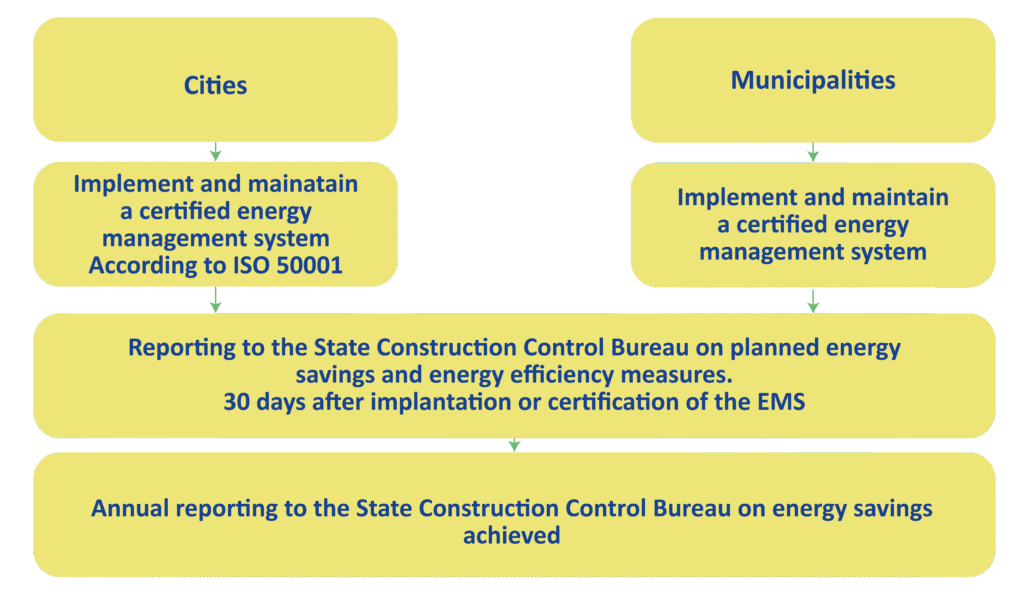EU example of EMS for municipalities
For example, according to the Energy Efficiency Law in Latvia, several key requirements are in place to promote energy efficiency across municipalities and large entities/companies. National cities are required to implement and maintain a certified energy management system, which must be validated by a certificate issued by an accredited certification body. For regional municipalities, implementing an energy management system is mandatory, though they have the discretion to decide whether to pursue certification. Entities with buildings larger than 10 000 m² must also implement and maintain an energy management system within one year of meeting these conditions. Furthermore, annual reporting on energy savings achieved is required to be submitted to the responsible authority, which is the State Construction Control Bureau. In terms of project evaluation, projects that utilize state, EU, or foreign funds receive additional points if they have an energy management system in place, following the relevant regulatory procedures. These measures aim to ensure that energy management practices are standardized and effectively contribute to energy savings across Latvia.
In the implementation of an Energy Management System (EMS) at the municipal level, several key factors must be addressed to ensure the efficient use of energy across public buildings. One of the primary concerns is whether all buildings are being maintained as efficiently as possible, with regular assessments of their structural and operational conditions. A thorough understanding of energy consumption patterns is essential—this includes monitoring heat consumption in each building and identifying any fluctuations or trends. Similarly, tracking electricity usage for each facility allows municipalities to pinpoint areas where energy savings can be achieved. It is crucial to have a clear understanding of how much is being spent on energy on a monthly and annual basis to develop more targeted energy-saving strategies.
 Figure 4: Municipal governments implement and maintain a certified energy management system
Figure 4: Municipal governments implement and maintain a certified energy management system
Beyond energy consumption, the quality of the indoor environment is also critical. Ensuring good air quality, particularly in schools and kindergartens, is vital for the health and well-being of occupants, and rooms must be well-ventilated to maintain a comfortable environment. Adequate lighting is another important aspect, contributing not only to comfort but also to energy efficiency if optimized correctly. Additionally, systems regulating heating need to be managed effectively to reduce unnecessary energy use, such as lowering heating levels during weekends or periods when buildings are not in use. By addressing these considerations, municipalities can significantly enhance the performance of their EMS, reduce energy costs, and contribute to overall sustainability goals.
It is also important to specify that the timing of development and certification can of course be better ensured through the support of external consultants who are experts in EMS development, implementation and certification.
The experience shows that Energy Management System helps to reach 3-8% energy and costs savings per year. For example, if municipality pays 1 million EUR for energy, it is 3-8% of energy savings that are achieved with small investments. The main point of EMS is to introduce systematic approach towards rational use of energy with available resources, i.e. with small investments and behaviour change. Once it is done, municipality can plan large investment projects based on real data and needs!
Official certification gives the municipality and its stakeholders formal recognition that its EMS has been set up according to a recognised international standard. Furthermore, this kind of a step tends to help guarantee that the municipality actually devotes itself towards a long-term commitment to maintain and improve the EMS over the years.
Additionally, it is worth mentioning that there already exist various mechanisms which have an official ISO 50001 certification as a pre-requisite (e.g. bonuses on white certificates, etc.), which itself may serve as an incentive to follow through on this important step.